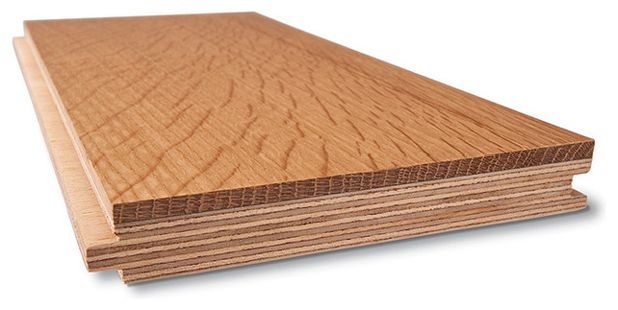Understanding Engineered Hardwood Floors
There are many hybrid flooring options that “look” like wood but aren’t actually made of any natural wood. This has created some confusion around the different products available, and lead some to believe if it’s “engineered” it’s fake. In order to remove the stigma, we want to provide an overview of the different types of engineered hardwood flooring, and how this product features natural wood throughout its composition.
Pre-finished Engineered Hardwood Flooring
Engineered is just a term to describe the construction of specific hardwood flooring. Instead of milling a solid piece, usually 3/4” thick and containing a tongue and groove milled into the sides for installation, engineered hardwood floors are made from alternating layers of thinner slices of hardwood to achieve a dimensionally stable and more indentation resistant plank.

Wood is a natural substance and has pores that will allow it to expand and contract with humidity and temperature changes. In solid wood, it is difficult to install wood planks that are over 4” wide because the expansion and contraction will cause gapping and “cupping” when the seasons change. The wider the wood, the more expansion and contraction you can expect. That’s where engineered hardwood flooring is beneficial.
Using Engineered Wood Flooring
Engineered wood is constructed by layering wood sheets, alternating the direction of the grain so that each layer is perpendicular to the other, which is the same method used to make plywood. What this does is balance the forces of expansion and contraction to create a dimensionally stable plank, even as the humidity and temperature change with the seasons.
After the layers are assembled, the planks are milled and can be produced in many widths without sacrificing dimensional stability as long as the platform was balanced to start. With the preference for longer and wider planks coming into fashion, the sale of engineered hardwood flooring products has exceeded solid wood in the overall market in recent years. All types of engineered hardwood flooring feature a real wood face, but there are differences in the materials used underneath the plank in the other layers.
Types of Engineered Hardwood Floors
All Wood Veneer Hardwood Floors

Veneer is just another word for sheet. We get wood veneer by either rotary peeling or by slicing/sawing the sheet out of the log. You get rotary peeled veneer through a process of pressing a knife blade or “lathe” against the length of the log and spinning it so that the sheets come off just like a roll of paper towels. Sliced or sawn face veneer is cut down the length of the log horizontally and can be cut in thicker faces and typically has more linear grain than rotary veneer. You would typically have sliced/sawn cut veneer only on the face layer. The other layers underneath in an all wood construction would be rotary because it is less expensive due to the higher yield per log. This still equates to a 100% wood plank.
Hybrid Plank with Real Wood Face
 Hybrid plank featuring composite core with real wood face are becoming more popular as they feature a combination of the best parts of both hardwood and laminate. You always want an actual wood face layer because the visual is natural and random. But laminate products contain a core material that is made from high-density fiberboard that is a wood composite. As long as the “HDF” core is of high quality, the indentation resistance usually increases in these products, and the dimensional stability is the same as with a veneer core hardwood.
Hybrid plank featuring composite core with real wood face are becoming more popular as they feature a combination of the best parts of both hardwood and laminate. You always want an actual wood face layer because the visual is natural and random. But laminate products contain a core material that is made from high-density fiberboard that is a wood composite. As long as the “HDF” core is of high quality, the indentation resistance usually increases in these products, and the dimensional stability is the same as with a veneer core hardwood.
Products that look like wood but are made from a printed visual that will have pattern repeat are found in Laminate, LVT, and WPC or Rigid core. Additionally, we are seeing ceramic tile be offered in wood looks! No doubt wood is a very popular visual, but just because it says “wood-look” doesn’t mean it’s the real deal. And just because it says “engineered” doesn’t mean it isn’t 100% “real hardwood.”
For more information about the benefits of engineered hardwood flooring for your home, contact Hearthwood today.
